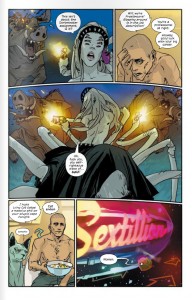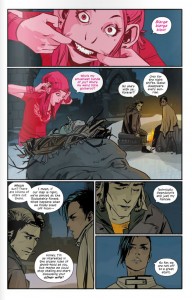Saga manages to be genuinely moving while at the same time not taking itself too seriously. Both the emotional depth and the air of levity feel entirely organic to the narrative. The excellent combination of charming and affecting is uniquely Vaughan, and he makes it look effortless—as all the best writers do.
 This is a series that you can expect to be surprised by without ever losing your sense of grounding in the story. Vaughan takes old tropes and twists them into something barely recognizable, but anchors the reader through that latent familiarity. Then, after hooking you in, he surprises you in every issue by bringing bizarre and completely new things to the stage. More and more with each installment, we learn that the universe of Saga is one where anything can happen.
This is a series that you can expect to be surprised by without ever losing your sense of grounding in the story. Vaughan takes old tropes and twists them into something barely recognizable, but anchors the reader through that latent familiarity. Then, after hooking you in, he surprises you in every issue by bringing bizarre and completely new things to the stage. More and more with each installment, we learn that the universe of Saga is one where anything can happen.
There’s less action in Saga #3 than the two previous installments, but that’s not necessarily a bad thing. It’s full of character, witty banter, and big reveals. There’s some not-so-subtle commentary on war and indigenous people, but it doesn’t feel like you’re being struck over the head with it.
As usual, Staples’ art continues to impress. There’s a particular scene in Saga #3 where the two freelancers, The Stalk and The Will, are on the phone together. In this scene, while somehow wrenching instantly recognizable expressions out of the six-eyed face of The Stalk, Staples’ art tells a continuous story in the background that the actual words don’t even mention. Her careful manipulation of expression, excellent understanding of body language, and the unmistakable humanity of her art works in such harmony with the humanity of Vaughan’s writing. At this point it’s hard to imagine Saga without Staples behind the panels.
A word of caution: think twice about reading your shiny new copy of Saga #4 in public. As if the topless spider-monster The Stalk left any doubt about Vaughan’s self-professed R-rating, in Saga #4 you’ve got a few pages of gratuitous sexual imagery when The Will visits a pleasure cruiser called “Sextillion.” It turns out to be even dirtier than it sounds, and stranger than you thought you’d ever see on a comic page. But then, in the midst of all this dehumanizing strangeness, there’s a moment that makes your heart sink. You feel sick as the depravity of the real world is served up in the guise of a comic panel. In this way, Saga is performing at the highest capacity of genre fiction: revealing the real through the fictive.
 The cracks in Alana and Marko’s relationship begin to reveal themselves, and we get a glimpse of how fragile this thing really is. Somehow that fragility makes us want it all the more, we love to root against the odds and Vaughan knows it. Marko and Alana have already sacrificed everything for their baby and for each other, but in every issue they are forced to sacrifice still more. Their survival teeters on a knife edge, the dogs of war are constantly at their heels. The tension is almost too much to bear, but it carries us forward, urges us onto that next page.
The cracks in Alana and Marko’s relationship begin to reveal themselves, and we get a glimpse of how fragile this thing really is. Somehow that fragility makes us want it all the more, we love to root against the odds and Vaughan knows it. Marko and Alana have already sacrificed everything for their baby and for each other, but in every issue they are forced to sacrifice still more. Their survival teeters on a knife edge, the dogs of war are constantly at their heels. The tension is almost too much to bear, but it carries us forward, urges us onto that next page.
Looking over the whole of Saga so far shows Vaughan’s impressive control of narrative momentum. He slows down after a boiling point long enough to show you the characters, to remind you why you love them, why you care about their success and why you’re rooting for them. And just when you get comfortable at the new pace, something dramatic explodes onto the scene and you’re hurled back into the action.
If you haven’t started reading Saga yet, I really don’t know what you’re waiting for. This is shaping up to be one of the best new titles of the year; Vaughan and Staples are a dream team.
[Have you picked up Saga? What are your thoughts so far? If you haven’t picked it up, what’s up with that? Let us know below.]